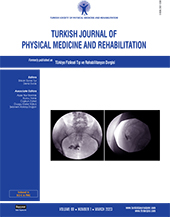The impact of the COVID-19 pandemic on children with disabilities and their parents or caregivers
2 Department of Physical Medicine and Rehabilitation, Koç University Faculty of Medicine, Istanbul, Türkiye
3 Department of Physical Medicine and Rehabilitation, Marmara University Faculty of Medicine, Istanbul, Türkiye
4 Department of Physical Medicine and Rehabilitation, University of Health Sciences, Gaziosmanpaşa Training and Research Hospital, Istanbul,, Türkiye DOI : 10.5606/tftrd.2023.10193 Objectives: The study aimed to determine the impact of the pandemic on parents/caregivers and children with neurologic disabilities.
Patients and methods: This multi-center cross-sectional study was conducted with 309 parents/caregivers (57 males, 252 females) and their 309 children (198 males, 111 females) with disabilities between July 5, 2020, and August 30, 2020. The parents/caregivers were able to answer the questions and had internet access. The survey included questions on the utilization of educational and health care services (whether they could obtain medicine, orthosis, botulinum toxin injection, or rehabilitation) during the pandemic. A Likert scale was used to evaluate the effect of the specific health domains, including mobility, spasticity, contractures, speech, communication, eating, academic, and emotional status. The Fear of COVID-19 Scale was used to assess fear of COVID-19.
Results: Among the children, 247 needed to visit their physician during the pandemic; however, 94% (n=233) of them could not attend their physician appointment or therapy sessions. The restricted life during the first wave of the pandemic in Türkiye had negatively affected 75% of the children with disabilities and 62% of their parents. From the perspective of the parents/caregivers, mobility, spasticity, and joint range of motion of the children were affected. Forty-four children required repeated injections of botulinum toxin; however, 91% could not be administered. The Fear of COVID-19 Scale scores were significantly higher in the parents who could not bring their children to the routine physician visit (p=0.041).
Conclusion: During the pandemic, access to physical therapy sessions was disrupted in children with neurological disabilities, and this may have harmful consequences on the functional status of children.
Keywords : Cerebral palsy, disability, pandemic

















